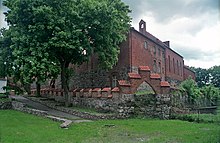Zamek Bierzgłowski
| Zamek Bierzgłowski | ||
|---|---|---|

|
|
|
| Basic data | ||
| State : | Poland | |
| Voivodeship : | Kuyavian Pomeranian | |
| Powiat : | Toruń | |
| Gmina : | Łubianka | |
| Geographic location : | 53 ° 6 ′ N , 18 ° 28 ′ E | |
| Residents : | 481 (March 31, 2011) | |
| Telephone code : | (+48) 56 | |
| License plate : | CTR | |
| administration | ||
| Website : | www.zamekbierzglowski.eu | |
Zamek Bierzgłowski ( German Birglau Castle ) is a district of the municipality Łubianka ( Luben ) in the powiat Toruński ( Thorn ) of the Polish Kuyavian-Pomeranian Voivodeship .
location
The place is located in the Kulmerland in the former West Prussia , about 14 kilometers northwest of the city of Toruń ( Thorn ) and 32 kilometers east of the city of Bydgoszcz ( Bromberg ). The village of Bierzgłowo ( Birglau ) is about 3 km away. Zamek Bierzgłowski had a train station on the Toruń – Chełmno railway line .
history
Until the end of the First World War, the village was an estate district, called Schloss Birglau , in the district of Thorn , district of Marienwerder , in the province of West Prussia .
There is a Gothic crusader castle from the time of the Teutonic Order , which was built in the years 1270–1305 instead of a castle built by the Teutonic Order around 1260 and which is one of the oldest of its kind. It was the seat of the Birgelow Commandery . The older castle was burned down after 1267, during the reign of Landmeister Ludwig von Baldersheim (1263–1269), when the Pruzzen invaded .
From 1520 onwards, Birglau Castle was owned by the city of Thorn.
In the 18th century, archaeological excavations in the sand hills in the area around Birglau Castle discovered numerous prehistoric graves.
After the First World War, the district with Birglau Castle had to be ceded to the Second Polish Republic in 1920 due to the provisions of the Versailles Treaty establishing the Polish Corridor . With the attack on Poland in 1939, the region was annexed by the German Reich in violation of international law . Birglau Castle was assigned with the Thorn district to the Bromberg administrative district in the Reichsgau Danzig-West Prussia .
After the end of the Second World War , the place came back to Poland.
Population development
| year | Residents | Remarks |
|---|---|---|
| 1831 | 157 | at twenty fireplaces (households) |
| 1864 | 198 | including 76 Evangelicals and 101 Catholics |
| 2012 | approx. 490 |
Attractions
- Castle, Polish Zamek w Bierzgłowie .
literature
- Karl Gotthelf Prätorius and Emil Wernicke: Topographical-historical-statistical description of the city of Thorn and its area, regarding the past and present. Volume 1, Lohde, Thorn 1832, pp. 254-259, point 3.
- Hans Maercker: History of the rural villages and the three smaller towns of the Thorn district in its earlier expansion before the branch of the Briesen i district. J. 1888 . Danzig 1899–1900, pp. 7–9, (restricted preview).
Web links
- Zamek w Bierzgłowie (Polish side towards the castle)
See also
Individual evidence
- ^ CIS 2011: Ludność w miejscowościach statystycznych według ekonomicznych grup wieku (Polish), March 31, 2011, accessed on July 6, 2017
- ↑ Friedrich August Voßberg : History of the Prussian coins and seals from the earliest times to the end of the rule of the Teutonic Order . Berlin 1843
- ↑ a b Julius Emil Wernicke : History Thorns from documents, documents and manuscripts . Volume 1: Years 1230-1530 . Thorn 1842, p. 31, footnote.
- ↑ Friedrich Samuel Bock : Attempt of an economic natural history of the Kingdom of East and West Prussia . Volume 2, Dessau 1783, pp. 573-574
- ^ Karl Gotthelf Prätorius and Emil Wernicke: Topographical-historical-statistical description of the city of Thorn and its area, regarding the past and present. Volume 1, Lohde, Thorn 1832, pp. 254-259, point 3.
- ^ E. Jacobson: Topographical-statistical manual for the district of Marienwerder , Danzig 1868, pp. 204–205, no. 16 .


